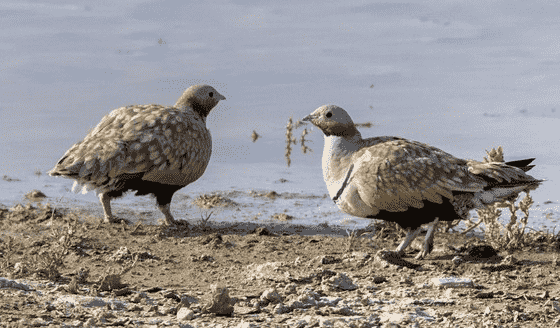Pterocles orientalis
IUCN
LCBasic Information
Scientific classification
- name:Pterocles orientalis
- Scientific Name:Pterocles orientalis,Black-bellied Sandgrouse
- Outline:Landfowl
- Family:order family genus
Vital signs
- length:29-34cm
- Weight:370-470g
- lifetime:About 20 years
Feature
Although it is also called "chicken", it is more closely related to pigeons.
Distribution and Habitat
Distributed in Afghanistan, Algeria, Azerbaijan, China, Cyprus, Egypt, India, Islamic Republic of Iran, Iraq, Israel, Jordan, Kazakhstan, Kuwait, Kyrgyzstan, Libya, Morocco, Pakistan, Portugal, Saudi Arabia, Spain, Syrian Arab Republic, Tajikistan, Tunisia, Turkey, Turkmenistan, Uzbekistan.
Migrant bird: Bahrain, Belgium, Germany, Greece, Lebanon, Malta, Nepal. Uncertain origin: United Arab Emirates.
In China, it is only distributed in Altay, Habahe, Hefeng, Bole, Fuhai, Tori in northern Xinjiang and Kashgar and Tianshan in the west.
The black-bellied sandgrouse lives in plains at the foot of mountains, grasslands, deserts and rocky fields.
Appearance
The black-bellied sandgrouse is a medium-sized bird with a beak similar in shape to that of a domestic chicken, but small and weak. The hind toe exists but is very short. The tail feathers are short and pointed and do not extend. Although it is also called "chicken", it is more distantly related to chickens than to pigeons. The male bird's head, neck and upper back are gray with grass yellow stains, the lower back, waist and upper tail coverts are dark gray, the central tail feathers are khaki with gray horizontal stripes, the tip is gray-green and has a narrow khaki edge, and the rest of the tail feathers have a wide white end spot, and the color gradually darkens, and the outermost pair of tail feathers become dark gray, with only brown stains at the base. The chin and throat are chestnut and extend to the side of the neck to form a neck ring. There is a triangular black spot on the lower part of the throat, which extends to the neck. The chest is gray, followed by a b
Details
Black-bellied Sandgrouse, there are 2 subspecies.

Black-bellied Sandgrouse is a summer migratory bird, migrating to the breeding grounds in spring from March to April, and leaving the breeding grounds in autumn from September to October, migrating in small groups.
The black-bellied sandgrouse moves in small groups, and sometimes gathers in large groups in winter. It is good at running and flying. When flying, its wings flap very quickly, often making a "whooshing" sound, and the flying speed is also relatively fast. During the day, it often flies to a water source dozens of kilometers away to drink water. The action of drinking water is very similar to that of pigeons. It puts its mouth into the water and swallows continuously without looking up. It mainly forages for plant seeds on the plains and deserts on the ground, and also eats plant leaves, buds and insects.
The breeding season of the black-bellied sandgrouse is May-June. It starts to pair up in mid-March. It usually nests in pairs on plains or low mountains, hills and deserts with sparse vegetation. Most of the nests are just pits on the ground, or the parent birds dig a shallow pit, without any bedding inside, or only a few small round stones. Each nest lays 2-3 eggs. The eggs are light gray and khaki, with slight green to olive spots, and are incubated by male and female birds in turn.
Listed in the 2013 Red List of Endangered Species of the World Conservation Union (IUCN) ver 3.1-Least Concern (LC).
Listed in the second level of the "List of National Key Protected Wildlife in China".
Protect wild animals and eliminate game.
Maintaining ecological balance is everyone's responsibility!








